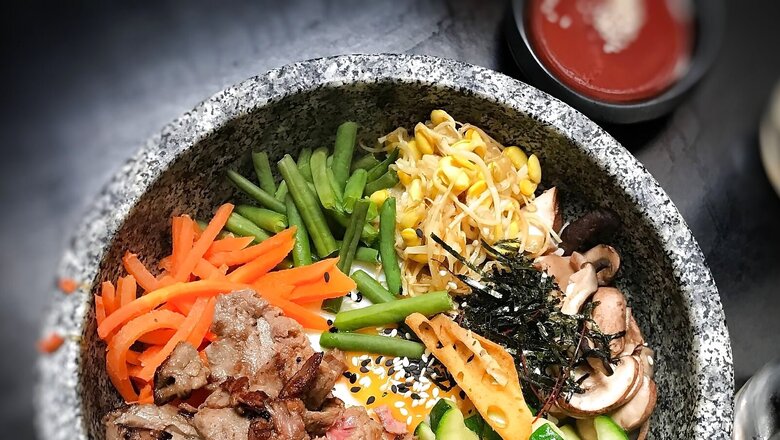
views
So let me start with my absolute favourite Rice cooked with meat, what else but a good old-fashioned Biryani. Most recipes available preach that you cook the rice and meat separately and then layer them in a vessel with fried onions, lemon juice, nuts, and saffron and then seal the pot and cook it on a slow fire. Not for me. I like my rice and meat cooked together and with potato. The classic method is to marinate the meat in hung curd and spices, layer the pot with ghee, fried onions, chunks of potato a bouqet garni of whole masalas, the marinated meat par boiled rice, saffron, dry fruits and then seal and slow cook for an hour or so. When done, the meat is tender, the rice flavoured and that intensely flavored, burnt layer of rice, masala, remnants of meat and squished potato at the bottom is heaven.
Irani and Mughlai restaurants in Mumbai have in the last few years started serving something called Kepsa. Once again, it’s rice and meat, but I’d never heard about it till now. Kepsa gets its name from Kabsa, a traditional dish of Saudi Arabia, also known as Mandi in other parts of the middle east. Kepsa here though is a combination of rice and kebabs. They have delicately spiced rice layered with birasta on top of juicy seekh kebabs or chicken tikkas or tandoori chicken. All the smoky and fried flavours combining to make a wholesome, robust Indian version. Then there is also the Raan Biryani, or better still Raan Tandoori with Chinese Fried Rice. I am not going to bother to explain this. You should go and try it.
Speaking of Chinese fried rice and other Asian flavours, I have a real weak spot for Korean Bibimbap. I first tried a Bibimbap in a tiny Korean Café called Bi Won near Holburn in London. Bibimbap simply translates to – rice with meat and assorted vegetables. Traditionally, Bibimbap is warm steamed rice raw beef and raw egg yolk along with other vegetables laid out picturesquely in a stone bowl. Served alongside are condiments and sauces like soy sauce, kimchi, gochujang (chili pepper paste) and doenjang (fermented soybean paste). I prefer the meat barbecued and the egg fried sunny side up. You stir in everything yourself and eat it. It’s multi-textured, and crunchy, strongly flavoured and a full meal.
And then there is Sushi. Traditionally, most sushi is made with raw fish, but what else is sushi if not meat and rice. Sushi in Japanese literally means “sour rice”, and it’s the rice that’s at the heart of sushi; vinegared rice along with raw vegetables and fish or meat. At a meeting in Singapore, a few years ago, it was decided that sushi would be a good idea for a quick working lunch. So food was ordered from a fancy wagyu restaurant called Ushidoki Wagyu Kaiseki. Amongst other things like Ozaki Beef Katsu Sando – a crunchy, panko-breaded and fried katsu (cutlet) sandwich made of toasted white bread, and with a tangy sauce, came an unbelievable Ozaki Beef Yukke Sushi. The best wagyu grilled to perfection in sushi with mixed with homemade sauce, yolk, sesame oil and spring onion. I now hunt for sushi and sashimi without fish, because I so prefer the meat.
The Italians make risotto. The first time I heard the word risotto was at my grandmother’s. She would cook a potful of rice with cheese and meat and serve it. It was nothing like the Italian risotto I grew to know as I travelled and discovered more about food, but it was exotic, whimsical and delicious. She’d cook up some rice in spices and tomato puree like you would for a one-pot Mexican rice. Only this was supposed to be French. To that tomato rice she’d add layers of fried onions, shredded sauteed chicken and big chunks of whole chicken liver. She’d then grate processed cheese on every layer and on the top of the pan as well. The pan would then be bunged into a warm oven, and kept there till the cheese melted brought all the layers together. Trust me, it was a hear-warming spicy and cheesy concoction, nothing like what a real risotto should be. Like a Risotto alla Milanese, – arborio rice cooked quickly in a soffritto of onion and butter or olive oil, stirred continuously, adding meaty broth and marrow, saffron and parmesan cheese, till plump and creamy.
I’m going to end with a Jambalaya. Never heard of it? Come on! The only place that makes it any more are the old clubs in the city. I know the Willingdon Club in Mumbai does one occasionally, as do a lot of old parsee ladies in their homes for dinner parties. Strangely, The Jambalaya it isn’t a Parsee or an Anglo dish. It’s Creole. A West African, dish with French and Spanish influence. It may also have a Cajun sway. It’s real comfort food. Meat and shrimp cooked together with onion, celery, and capsicums, sautéed in the fat of sausage with garlic, herbs and Cajun spices in tomato rice. It tastes even better than it sounds. The ultimate one pot rice and meat meal.
(The views expressed in this article are those of the author and do not represent the stand of this publication.)
Kunal Vijayakar is a food writer based in Mumbai. He tweets @kunalvijayakar and can be followed on Instagram @kunalvijayakar. His YouTube channel is called Khaane Mein Kya Hai.
Read all the Latest News, Breaking News and Coronavirus News here.



















Comments
0 comment